On January 18th Thomas and I participated in a two-day survival training program that is mandatory for all Soyuz crewmembers and is meant to provide astronauts and cosmonauts the skills and confidence necessary to survive in cold weather. While the rescue teams typically arrive on the Soyuz landing site even before the capsule has made ground contact in case of a planned descent, an unplanned emergency reentry is a possibility at any time during autonomous flight or while docked at ISS. In the worst case scenario, even during initial ascent as a consequence of rocket failure.
Here is my attempt at sharing with you our experience in the woods surrounding Star City.
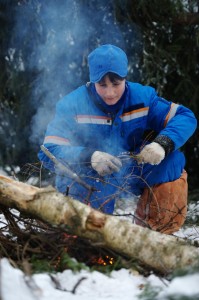
Getting the fire started (Credit: GCTC)
I could watch forever the hypnotic dancing of the flames. Still, my one hour night watch is over: it’s time to wake up my crew mate and try to get some sleep. As Thomas stretches his limbs, rigid from the cold and the frugal mattress of leaves and branches , I make a quick radio call reporting that our crew is doing well. Yesterday, during our first night of survival, the procedure was different: stranded and with no contact to rescue teams, we would make three MAYDAY calls in the blind at every full hour, in intervals of 2 minutes. Unnecessary procedure now, since we have been located!
Last night we made simulated contact with a rescue helicopter. On their request, we lit our signaling fire and a night flare so that they could pinpoint our position. As expected, we were told that we would be rescued only the following morning and so here we are, in our tepee, in what is now mainly an exercise in patience and cold endurance.
Truth to be told,we really can’t complain. It’s -15°C tonight with hardly any wind; snow on the ground is knee-high. I rejoice at our good luck when I think of the many accounts of crews going through their training in chest-high snow and -30°C. Even so, it seemed like a daunting task ahead when, two days ago, we were helped into the Sokol flight suits and told to climb into an old Soyuz descent module that was laying on its side in the survival area. Awaiting us inside, packed in the little volume available, the standard Soyuz survival kit and cold-weather clothing. Awaiting us outside, the parachute canopy and ropes,three seat liners that we would normally remove from the seats and thigh-high water-proof footwear that we would normally cut out from the Forel water survival suit.
Thomas has entered first. Finding him oddly perched above the control panel, I hunker down in a corner, trying to make space for our commander, Sergey, to enter as well and close the hatch behind him. A quick radio call, and the training begins.
Keeping dry, pacing ourselves so as not to sweat, has been touted as the number one advice to prevent hypothermia and is a brightly present resolution in my mind. This notwithstanding, after a few minutes we are all in a sweat. In the confined volume, we search and unwrap the components of our winter survival clothing, each marked with our name: the jumper suit, the sweater, the light jacket, the thick overall, the heavy jacket. And then gloves, hat, footwear. As I help Sergey out of the Sokol and try to pass him the appropriate clothing elements, I can’t help to be grateful that none of us is particularly big!
By the time we make our way into the woods, after having gathered the survival gear and the parachute in the seat liners, we have about 4 hours of sunlight left.
We don’t have to worry about food, as there is sufficient supply for at least three days, but we’ll have to work quickly to have our shelter, our signalling fire and our firewood ready by nightfall. Sergey spots a good place for our camp: two straight trees at about two meter distance for our lean-to shelter, plenty of space in front to build our tepee the next day on the area that will be heated by tonight’s fire, a clearing about 100 meters away for our signalling fire.
With the resolute, but endearingly gracious leadership style that Thomas and I will quickly come to appreciate, Sergey distributes the tasks and gets the work going. A former Blackjack pilot in the Russian Air Force, our commander has great outdoor skills and a natural instinct for taking care of everybody’s needs. Another great fortune, and one that will be pivotal in creating the smooth and warm atmosphere among ourselves that will remain as a cherished memory.
Sharing one knife and one machete from the survival gear, we use medium size branches and parachute rope to build the framework of our lean-to shelter. We then cover both the floor and the roof with a sizeable amount of branches and leaves and wrap everything in parachute material and reflective survival blanket. It’s not a palace, but it will do, and I will actually get a few hours of sleep tonight, in stints of 20 to 30 minutes.
No comparison, of course, with our shelter for the second night. With the entire day at our disposal, the instruction is to build a tepee. After constructing the conical framework with 6 long tree trunks, we wrap the parachute around it: one internal lower layer, about chest high, and one external upper layer, which leaves an opening at the top. By inserting 30cm long sticks between the two layers, we create a gap for fresh air to flow in, while smoke from the fire is evacuated from the top opening.
So here I am, passing the radio to Thomas and trying to go to sleep. In a few hours we will be contacted by the rescue helicopter and be given an azimuth to follow to the recovery area. We know from the briefing that one of us will have to simulate a broken limb, so we will have poles ready to make an improvised stretcher from a seat liner.
Once it is all over, I fancy that we will light a signalling flare in celebration. And one last thought as I slip into a light sleep: let that post-training sauna tomorrow be nice and hot!










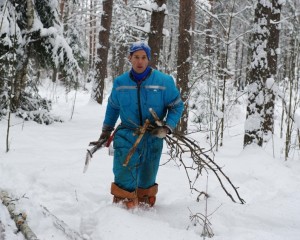
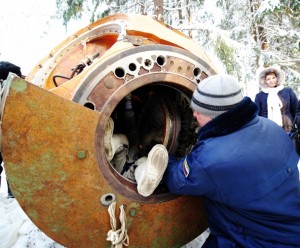
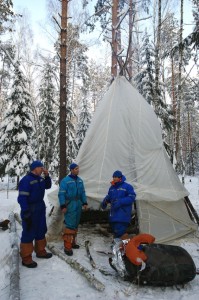
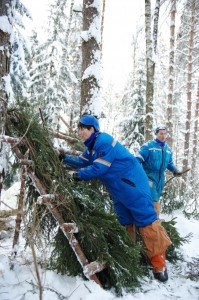
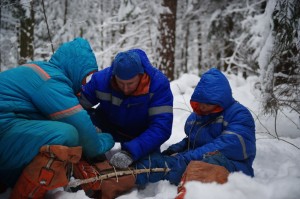
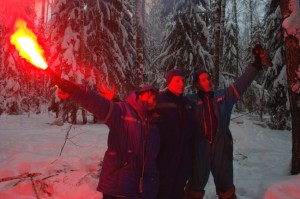
Discussion: 13 comments
Hi! Thanks Samantha for this blog entry!
Why do you sleep in stints? Do you always need to have one person alert? What are the potential dangers of the night, if any?
Thanks for reading!
I slept in stints mainly because of the cold. There is no special danger in the night, but someone has to stay awake to keep the fire going and make the radio calls.
Полезная тренировка! Достаточно вспомнить приземление экипажа корабля «Восход-2» с космонавтами Беляевым и Леоновым на борту 19 марта 1965 года. Посадка произошла в заснеженной тайге, далеко от населённых пунктов. Космонавты пробыли трое суток в тайге, пока их не обнаружили. Вертолёт не мог приземлиться поблизости. Площадка для вертолёта была оборудована на следующий день в 9 км от места приземления. Космонавты и спасатели добирались до вертолёта на лыжах.
Спасибо за очень интересную историю!
Where does all that bulky clothing and survival gear fit within the Soyuz descent module? In the white fabric bags above the seat liners?
The clothing items are distributed in several soft bags, which fill up gaps between the main and backup chute containers inside the descent module, and between those containers and the shell. It helps that they are very much compressed when they are packed, especially the thick winter overall and jacket.
Very interesting post, Samantha. Thanks for sharing your training adventure.
I was wondering why you don’t have a real tent for emergencies and instead you have to build a tepee with trees and parachutes. These kind of tents are very light (about 5 kilos) and fast to assemble, and thay can host three people. You would have sleep warmer also during the first night 😉
I’m sure it would be practical and comfortable. However, just as examples: we also don’t have an inflatable raft, and we are limited to 6 liters of water, while more might be useful if you land in a very hot desert area. At some point you have to draw the line and make compromises 🙂
I’ve already built a tepee, do I get more points in my application to be an astronaut? 😉 By the way, I heard from Jean-François Clervoy that you already have a flight scheduled, is that right? I might have misunderstood what he said, but he was talking about some contracts Italy has on its own. If so, are you going to use the exact same equipment that you’re training on? For example using this kind of descent module, etc…
Ну спосибо большое, мне так нравится читать этот блог, это генялно! J’attends la suite avec impatience 😀
I am not assigned to an ISS expedition yet. The descent module used for survival is from an earlier version of Soyuz. However, since the point of the exercise is to change in the confined volume, and the volume hasn’t changed, using an old descent module is perfectly OK 🙂
Thanks for your interest!
Wasn’t there a Soviet space mission long ago which landed far away from the scheduled landing site in a dense forestand the crew had to fight against hungry wolves?
“I can’t help to be grateful that none of us is particularly big!”
Is there a size limitation purposefully built into the Space program, American or otherwise? It’s interesting to myself on two fronts.
1. I’m 6 foot 3 inches tall (1.9 meters) and weigh on the average 220 pounds (99.7 kilograms).
2. The average size of humans has significantly changed over the course of time.
As the average size of our species increases fundamentally physics remain the same and because of this, which human size may be environmentally driven, I would assume that a contingency plan, or protocol, would indeed be in place. If so does this protocol differ between the European and American space agencies?
At any rate it was great to have had the opportunity to share in your survival experience Samantha. 🙂
Hi,
do I understand correctly that you’re asking if there are maximum limits for anthropometric measurement in selecting astronauts? If so, yes, there are. But you need to be really very tall to be over the limit. I think you would be fine.
I’m not sure I understand your question about the contingency plan or protocol. What contingency are you referring to?
Thanks!
Samantha